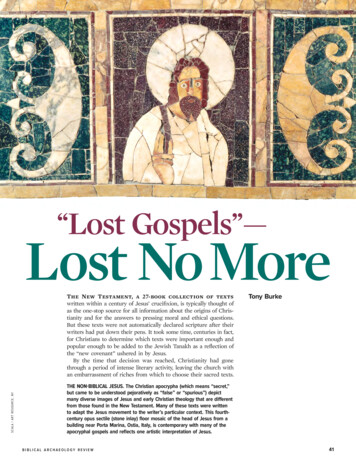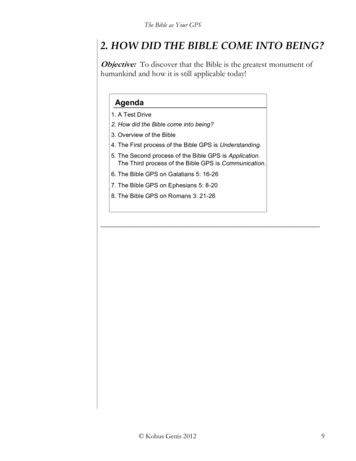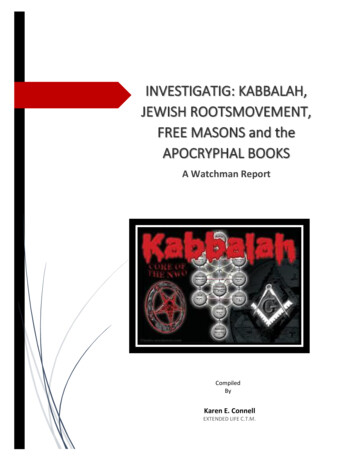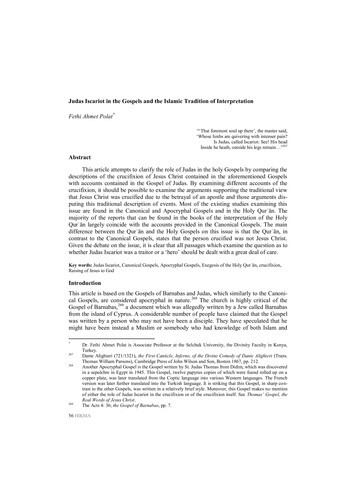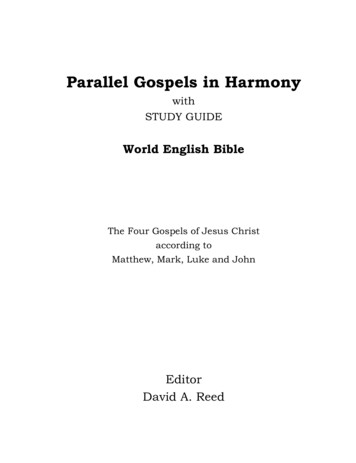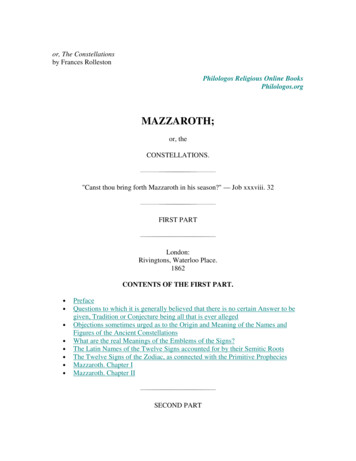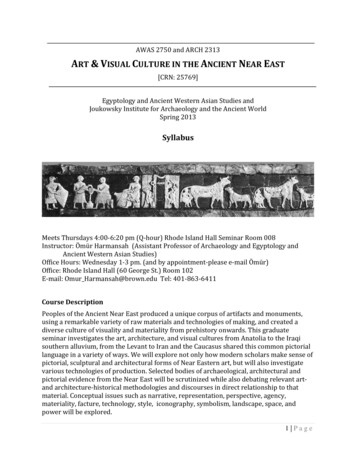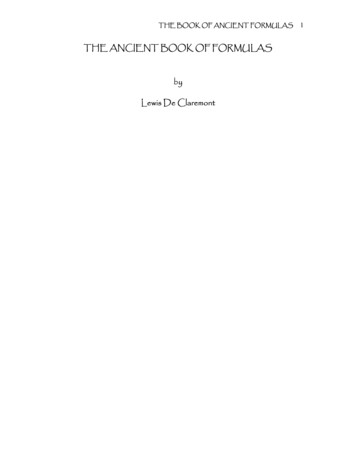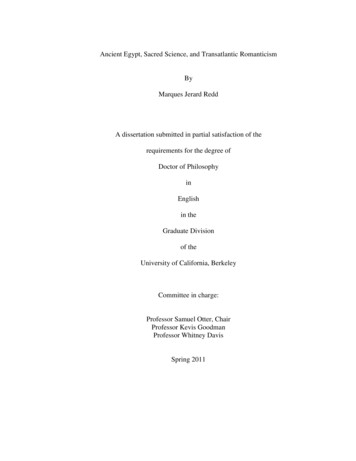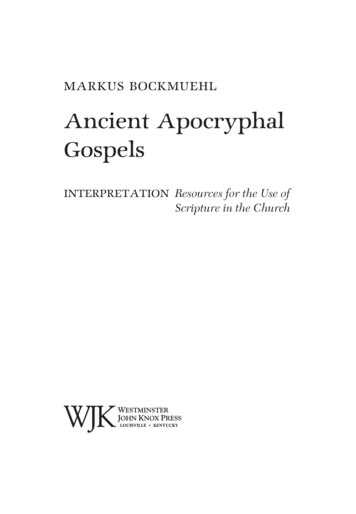
Transcription
MARKUS BOCKMUEHLAncient ApocryphalGospelsInterpretation Resources for the Use ofScripture in the ChurchBrockMuehl Pages.indd 311/11/16 9:39 AM
2017 Markus BockmuehlFirst editionPublished by Westminster John Knox PressLouisville, Kentucky17 18 19 20 21 22 23 24 25 26—10 9 8 7 6 5 4 3 2 1All rights reserved. No part of this book may be reproduced or transmitted in any formor by any means, electronic or mechanical, including photocopying, recording, or by anyinformation storage or retrieval system, without permission in writing from the publisher. For information, address Westminster John Knox Press, 100 Witherspoon Street,Louisville, Kentucky 40202- 1396. Or contact us online at www.wjkbooks.com.Scripture quotations are from the New Revised Standard Version of the Bible, copyright 1989 by the Division of Christian Education of the National Council of the Churchesof Christ in the U.S.A. and are used by permission.Map of Oxyrhynchus is printed with permission by Biblical Archaeology Review.Book design by Drew StevensCover design by designpointinc.comLibrary of Congress Cataloging- in- Publication DataNames: Bockmuehl, Markus N. A., author.Title: Ancient apocryphal gospels / Markus Bockmuehl.Description: Louisville, KY : Westminster John Knox Press, 2017. Series:Interpretation: resources for the use of scripture in the church Includesbibliographical references and index.Identifiers: LCCN 2016032962 (print) LCCN 2016044809 (ebook) ISBN 9780664235895 (hbk. : alk. paper) ISBN 9781611646801 (ebook)Subjects: LCSH: Apocryphal Gospels—Criticism, interpretation, etc. Apocryphalbooks (New Testament)—Criticism, interpretation, etc.Classification: LCC BS2851 .B63 2017 (print) LCC BS2851 (ebook) DDC 229/.8—dc23LC record available at https://lccn.loc.gov/2016032962The paper used in this publication meets the minimum requirements of theAmerican National Standard for Information Sciences—Permanence ofPaper for Printed Library Materials, ANSI Z39.48- 1992.Most Westminster John Knox Press books are available at special quantity discountswhen purchased in bulk by corporations, organizations, and special- interest groups.For more information, please e- mail SpecialSales@wjkbooks.com.BrockMuehl Pages.indd 411/11/16 9:39 AM
ContentsSeries r 1: Ancient Christian GospelsThe Four Gospels—and the OthersWho Read What in the Early Church?The (Re)Discovery of Noncanonical Gospels“Gnosticism”?—A DefinitionGospels of the Original Jesus, Suppressed byan Authoritarian Church?The Design and Approach of This BookHow Many Apocryphal Gospels?What Makes a Gospel “Apocryphal”?How to Organize the Texts: A TaxonomyWhere to Read the Noncanonical Gospels Today18101418Chapter 2: Infancy GospelsWhy Infancy Gospels?The Infancy Gospel of JamesThe Infancy Gospel of ThomasOther Infancy TextsConclusion: Infancy Gospels555558728084Chapter 3: Ministry GospelsThe Problem of “Fragmentary” GospelsA Note on Q“Jewish Christian” Gospels?Ministry Gospels on PapyrusPapyrus Egerton 2 ( Papyrus Köln 255)“Papyrus” Oxyrhynchus 840Other Papyrus FragmentsA Secret Gospel of Mark?BrockMuehl Pages.indd 52128313848518787899210410611011412011/11/16 9:39 AM
The Abgar LegendAlternative Whole Narrative Gospels?Conclusion: Ministry GospelsChapter 4: Passion GospelsThe Gospel of PeterThe Unknown Berlin Gospel/Gospelof the Savior (P.Berl. 22220)The Strasbourg Coptic Papyrus (P.Argent.Copt. 5, 6, 7)The Discourse on the Cross (Nubian Stauros Text)Passion Gospels Associated with Pilate, Nicodemus,and Joseph of ArimatheaGospels of Gamaliel?Conclusion: Passion GospelsChapter 5: Post- ResurrectionDiscourse GospelsNew Testament Origins?The Gospel of ThomasThe Gospel of PhilipOther Dialogue “Gospels” or Gospel- Like Textsfrom Nag HammadiThe Gospel of MaryThe Gospel of Judas (Codex Tchacos)Gospels of the EgyptiansGospel of BartholomewThe Epistle of the ApostlesConclusion: Post- Resurrection Discourse 83190199204210212215220Chapter 6: How to Read Apocryphal Gospels 225BrockMuehl Pages.indd 6Glossary of Technical Terms239Bibliography243Index of Scripture and Other Ancient Sources291Index of Subjects30211/11/16 9:39 AM
Chapter 1Ancient Christian GospelsChristians since antiquity have grounded their faith on its authentic attestation in the gospel of Jesus Christ received from his firstapostles. This grounding is already explicit in the Bible itself andhas remained an uncontroversial aspect of historic Christian praxisand worship since antiquity.Throughout their history, churches of virtually every stripehave—for all their tacit or fiercely contested differences—shareda core conviction about Jesus of Nazareth as in some sense botha human being in history and yet also “God with us.” Jesus hasalways been encountered and experienced in a variety of ways.Most prominent since antiquity have been practices of prayer andcommon worship that include a liturgical meal celebrating both hismemory and his presence, accompanied by the public reading ofthe four gospels—authoritative writings about his teachings andministry received in the names of his earliest disciples.But the early Christian use of gospels also has a fascinatingdynamic of its own, operating in theologically powerful and yet surprisingly polyvalent ways in diverse periods and communities.The term “gospel” surfaces in the earliest tradition as characterizing Jesus’ message. Matthew and Mark both present “the gospel”(to euangelion) as the radical message and praxis of Jesus about theimminent coming of God’s kingdom (see esp. Mark 1:14–15; 8:35;10:29; 13:10; Matt. 4:23; 9:35; 24:14). Luke, who is more aware ofBrockMuehl Pages.indd 1111/11/16 9:39 AM
Ancient Apocryphal Gospels2BrockMuehl Pages.indd 2the public, imperial context of his writing, does not seem to like thisnoun, for reasons that will become apparent in a moment. He neveruses it in his gospel, and in Acts it appears only once each on thelips of Peter and of Paul (Acts 15:7; 20:24). The verb “to announcegood news” (euangelizomai), on the other hand, occurs frequentlyin both Luke and Acts.Even Matthew and Mark, however, already show a transition inmeaning that evidently occurred at a very early stage in the tradition—it is in fact already complete in the Letters of Paul, whichpredate all four New Testament gospels. Whereas “the gospel” inMatthew and Mark almost invariably reports what Jesus himselfpreaches and enacts, even here there are signs that by the timeof these evangelists “the gospel” has become the content of themessage he entrusts to his disciples, and indeed the message abouthim. So Matthew’s Jesus himself can promise that “this gospel ofthe kingdom” will be proclaimed throughout the world after hisdeath (Matt. 24:14; 26:13). And Mark 1:1 opens with the words,“The beginning of the gospel of Jesus Christ”—a famously ambiguous phrase that leaves unresolved whether the gospel here in viewis Jesus’ message (as in 1:14), the message about Jesus (e.g., 13:10;14:9), or perhaps even—by a kind of metonymy—Mark’s own bookthat sets forth this message. But it clearly involves the person ofJesus, including his message and ministry as well as his death.Additionally, and well before Mark writes his account, itis already clear that when in the early 50s Paul preached to theCorinthians the gospel by which they are saved, this entailed at aminimum a narrative passion and resurrection sequence involving “Christ died for our sins, . . . he was buried, . . . he was raisedon the third day, . . . he appeared to Cephas, then to the twelve,then” to many others in succession (1 Cor. 15:1–6; cf. 2 Tim. 1:10;2:8). There seems moreover to be continuity here with the similarly sequential narrative, quoted a few chapters earlier, of wordsand actions of Jesus “on the night when he was betrayed” (1 Cor.11:23–25).A few decades later, in a more retrospective account of Peter’sfirst preaching to the Gentiles during the mid- 30s, the narrativeof Acts has Peter assuring his audience at the house of Corneliusabout “the word” God sent to the children of Israel, “proclaimingthe good news [euangelizomenos]” of peace through Jesus Christ(Acts 10:36, my translation). That “word” (logos), he goes on to say,11/11/16 9:39 AM
Ancient Christian Gospelscame to expression through the “message” (rhēma) associated withcertain particular events that recently transpired in Jewish Palestine,beginning in Galilee after the baptism that John announced: howGod anointed Jesus of Nazareth with the Holy Spirit and withpower; how he went about doing good and healing all who wereoppressed by the devil, for God was with him. We are witnessesto all that he did both in Judea and in Jerusalem. They put him todeath by hanging him on a tree; but God raised him on the thirdday and allowed him to appear, not to all the people but to us whowere chosen by God as witnesses, and who ate and drank withhim after he rose from the dead. (Acts 10:37–41, NRSV)In other words, even the earliest stages of the tradition, bothas attested in Paul and as attributed to the remembered Peter inActs, envisaged the gospel to include a narrative about Jesus’ publicministry and message, culminating in his death and resurrection.(Significantly, Luke places a Mark- like apostolic gospel outlineon Peter’s lips. This is despite its obvious divergences from thestructure of Luke’s own gospel account with its addition of birth,infancy, and ascension stories.)Readers familiar with the gospels and with cognate Englishwords like “evangelical” are sometimes surprised to discover theextent of scholarly debate and controversy about the origin andprecise meaning of the early Christian use of the term euangelion.One school of thought has long stressed the conviction that theterm must be understood as originating in connection with theHellenistic use of euangelia (Greek plural) to denote “happy news”or “good news”—as used in the eastern empire most publiclyin relation to official Roman imperial announcements aboutgood news like the accession, birthday, or victory in battle of theemperor as “Savior” (sōtēr, a word the New Testament uses muchmore sparingly than later Christian tradition). The most famouspre- Christian example is an inscription in praise of the birthdayof Caesar Augustus that was erected at Priene and other cities inAsia Minor in 9 BCE. He is celebrated as “our God” whose birth“signified the beginning of happy news [euangelia] for the entireworld.” Even without using the word “gospel,” the Roman poetVirgil’s famous Fourth Eclogue, composed around 42 BCE, deploysIsaiah- like imagery in anticipation of an age of eschatological peaceand salvation associated with the birth of an unnamed child (thoughBrockMuehl Pages.indd 3311/11/16 9:39 AM
Ancient Apocryphal Gospels4BrockMuehl Pages.indd 4not perhaps identifiable as the hoped- for son of Mark Antony andhis wife Octavia, as scholars used to think).The notion of public good news had been common currencyfor many centuries, being attested ever since Homer (Odyssey14.152, 166: euangelion, singular). Indeed the commonplaceinflation of such terminology could even become the butt of jokes:the Athenian comic playwright Aristophanes (ca. 446–386 BCE)already had a sausage seller poking fun at bawdy market hyperboleby intoning, “Hey, Senators, I’m the first with tremendous news[euangelisasthai]: never since the war began have sardines been socheap” (Knights 642–45; trans. Roche 2005). The familiarity of suchterminology can be gauged too by its adoption as a Latin loan word:the Roman writer Cicero repeatedly and somewhat informally doesthis, as when writing to his friend Atticus in 60 BCE, “First, I havewhat I think is good news [euangelia] . . .” (Letters to Atticus 2.3.1).One might think, therefore, that Christian talk of to euangelion,the good news, basically just recycled for Jesus a well- known clichéthat could evoke little more than a yawning response. That wouldhardly convey the sort of grandly anti- imperial ambition which theclaim of a Christian euangelion is sometimes said to advance. Tobe sure, resistance to the force of empire soon became at least asporadic occurrence—and sometimes part of the very essence ofwhat it meant to be a Christian, as stories about the trials of martyrsrepeatedly affirm. But despite sometimes heated scholarly debate, itremains difficult to document in the New Testament any sense thatthe use of the term “gospel” serves a clear anti- imperial function.A related line of argument has sometimes taken such earlyChristian terminology to imply the church’s origin not as a PalestinianJewish messianic movement but as a Hellenistic divinized hero cult,drawing on culturally commonplace idioms and assumptions aboutheroes or rulers.But to acknowledge the existence of such potential Hellenisticresonance is not yet to understand what a (or the) gospel conveysin the early Christian texts. Even for Greek- speaking Jews andChristians, gospel language must have carried a kind of dualsignificance. On one hand, there will have been at least an awarenessof the secular use of “good news,” sometimes exploited in theservice of ideological ends and propaganda. Jewish writers in Greeklike Philo and Josephus repeatedly illustrate the currency of such a11/11/16 9:39 AM
Ancient Christian Gospelsmeaning of “good news.” Secular as well as religious overtones wereindeed in the air, even for Jews.On the other hand, however, we must recognize that the Greekterminology was also already part of a richly textured discourse ofprophetic and divine communication in older, pre- Christian JewishGreek Scriptures. In that respect the Greek words conveyed aJewish, Old Testament meaning—often associated with the secondpart of the book of Isaiah, which announces the Servant of theLord’s return to redeem Jerusalem (52:7) and speaks of “goodnews” to the afflicted and imprisoned (61:1, both times using theverb euangelisasthai). While the Greek Old Testament does notdeploy the noun “gospel” in this fashion in either the singular or theplural, the formative role of widely influential texts like these in theearly Christian understanding of the gospel of Jesus is clear. OtherJewish texts in Greek like Psalms of Solomon 11:1 clearly highlightsuch usage, and Paul quite confidently appropriates Isaiah 52:7 inspeaking of the activity of the apostles as proclaimers of a messagethat is “the gospel” (see Rom. 10:15–16; cf. 1 Cor. 9:14; also Stanton2013, 281–92 and passim and Horbury 2005, 2006).Unlike the Greco- Roman use almost exclusively of the pluraleuangelia, the early Christian writers deploy the singular “gospel”(euangelion) consistently and uniquely in relation to the messageof or about Jesus. That said, even here there is some evidenceof semantic ambiguity from the start. As we saw earlier, Jesus’message soon became the message about him (Mark 1:1; 14:9;and 16:15; note esp. Matt. 26:13; 24:14, “this gospel,” i.e., not onlyJesus’ words and actions but evidently an account of that messageand ministry—such as Matthew himself provides; cf. Stanton 2013,95–98). Already in the corpus of Pauline Letters the term came tobe used interchangeably for either the message or its content: theapostle speaks of both “the gospel” and “my gospel” (cf. Phlm. 13with 2 Tim. 2:8 and Rom. 16:25).As already noted, Luke never uses the noun “gospel” in hisnarrative of Jesus (but see Acts 15:7; 20:24), although he doesdeploy the cognate verb twenty- five times in Luke and Acts. InActs 13:32–33 he places on Paul’s lips a definition of what it meansto preach the gospel: “we bring you the good news that what Godpromised to our ancestors he has fulfilled for us, their children, byraising Jesus.” The New Testament’s Johannine writings avoid theBrockMuehl Pages.indd 5511/11/16 9:39 AM
Ancient Apocryphal Gospels6BrockMuehl Pages.indd 6Greek euangel- word group altogether except at Revelation 10:7 aswell as at 14:6, where it denotes a message of judgment.Matthew’s usage in particular evidently had a powerfulinfluence on subsequent understanding of what the gospel mightbe. Very rapidly, its range of meaning expanded from Jesus’kingdom message or (as in Paul, e.g., 1 Cor. 15) the messageabout Jesus’ death and resurrection to include accounts of his life,preaching, innocent death, and resurrection “for us.” As we sawearlier, an early narrative form of this is implied in Peter’s accountin Acts 10:34–42, and in the writings of Ignatius (d. ca. 107) it isalready evident that “the gospel” designates for him the crucifixion- resurrection message of Jesus (Smyrnaeans 7.2), quite possibly inits Matthean form (cf. Smyrnaeans 1.1 with Matt. 3:15; similarly cf.Didache 8.2 with Matt. 6:9–13; also 2 Clement 8.5, more loosely,with Luke 16:10–11; see further Hill 2006; Foster 2005).Significantly, not later than the middle of the second centurythe notion of this gospel story “according to” one apostolic figureor another had become attached to gospel books—for example, inJustin, First Apology 66.3 (see Stanton 2013, 92–97). A little beforethis, Marcion had already identified his edition of Luke as “thegospel.” Similar examples can be found in other early documents:the form of the Didache’s reference to its source suggests that “thegospel” was already used to designate “a gospel writing, almostcertainly Matthew, some decades before Marcion” (thus Stanton2013, 77; cf. Kelhoffer 2014, 72).If this is correct it follows, importantly, that known portions ofone or more of the subsequently canonical gospels were known andcited as “the gospel” before any of the extant noncanonical gospelswere composed. To some extent this is inevitably a judgmentabout a serendipitous state of affairs at this present time, whichthe discovery of new sources or compelling reassessments ofexisting ones might require us to revise. And absence of evidenceis not evidence of absence. But in the meantime it matters for ourassessment of recent and current claims that while specific literaryidentifications are sometimes difficult or textually ambiguous (e.g.,Luke 16:10–11 in 2 Clement 8.5, cited above), no ancient authorrefers to any identifiable version of a noncanonical text like Thomasor Q as “the gospel.”Further on this note, it has been repeatedly shown (e.g.,Hengel 1984; Gathercole 2013) that while the titles of the existing11/11/16 9:39 AM
Ancient Christian GospelsNew Testament gospels are clearly not from the pen of theoriginal authors, they and the associated authorial attributions arenevertheless both stable and remarkably early, probably from thefirst half of the second century. Although in theory compatible withsimplistic explanations in terms of wholesale deliberate “forgery,”as Ehrman (2013) prefers, such a date makes it difficult to rule outthe possibility that these apostolic attributions are instead based insome fashion, whether correctly or in error, on an existing chain ofcollective or individual living memory.Manuscript evidence suggests that the short forms “according toMatthew” or “according to Luke” are secondary abbreviations froman original longer form, “the gospel according to” Matthew or Luke;see, for example, Gathercole 2013. (Gathercole 2012b illustratesthis same usage in the flyleaf of Matthew included with manuscript 4, dating from ca. 200. Thus Bovon’s assertion that “we have nocodices [with inscriptio and subscriptio] of these gospels predatingtheir canonization” [1988, 20–23] turns out to be an argumentfrom increasingly partial silence, which will require fuller facts andrather more nuance. It is hardly the comprehensive refutation ofthe “extravagant claims of Martin Hengel” that Ehrman [2013, 53and 53n55] imagines).Hengel additionally observes that while the title “gospel” isroutinely introduced in reference to other gospels like Thomas orNag Hammadi’s Gospel of the Egyptians, it is never lost from a textthat has once been so designated—even though gospel status itselfseems to fade from interest for later compositions at Nag Hammadi,where “dialogues” and “revelations” predominate over narrativesof the earthly Jesus. Among other things, this suggests that therelatively rapid successive publication of the Synoptic Gospelsbetween the 60s and the 90s, designated within a few decades as“the gospel according to X,” may have established a compellingprecedent for the choice of titles in later accounts of the teachings ofJesus. This precedent entailed both the term “gospel” and the nameof an apostolic guarantor, as evidenced not only in John but also inseveral noncanonical gospels. (See Hengel 2008b, 110–11, 182–83.)A related point concerns certain material aspects of conservationand innovation in gospel writing. As we will see, there appears fromthe start to be greater textual stability in the extant manuscripts ofsubsequently canonical gospels than in those of Thomas, Peter, andother apocryphal gospels. In relation to this it has been plausiblyBrockMuehl Pages.indd 7711/11/16 9:39 AM
Ancient Apocryphal Gospelssuggested that the more widespread copying, liturgical reading,and memorization would have had a stabilizing effect on the textualtradition, certainly allowing for the composition of new gospels (likeMatthew or Luke) but largely eliminating the scope for successivetextual recensions of the same text (Evans 2015, 36–37). WhileEvans’s related inferences about the longevity of New Testamentautographs look a little problematic in their specificity, a manuscriptlifespan of a century and a half was indeed a reasonable expectation(see, e.g., Houston 2014, 175, on Oxyrhynchus)—and mightreinforce this stability for texts that circulated widely.Except for scribal identifications in titles or colophons (i.e.,concluding scribal comments), the term “gospel” itself is remarkablyrare in the body of ancient gospel- like texts at Nag Hammadi orelsewhere. Leaving aside late works like the Gospel of Nicodemus(B 14.1) or the History of Joseph the Carpenter (1.2; 30.3), the smallhandful of examples from antiquity includes the Gospel of Mary (9;18) and the Gospel of Truth (17.1–4; 18.11; 34.34–35) for the savingmessage about Jesus. Nag Hammadi’s Sophia of Jesus Christ, in aquestion about why “in the gospel” (evidently a text!) Sophia’s Sonis called “human” and the “Son of Man” (104.1), also demonstratesthis meaning.The Four Gospels—and the Others8BrockMuehl Pages.indd 8Until the nineteenth century, Western biblical scholars tended totake for granted that the emergence of the early church was basedon “one holy catholic and apostolic” faith and that the canon ofScripture was essentially the result of a continuous and intentionally advancing original movement from which others deviated.However challenged that movement may have been by detractorswithout and heretics within, on this view it proceeded organicallyfrom Christ to the apostles, to the fourfold apostolic gospel and theNew Testament read in light of the apostolic rule of faith (regulafidei). This in turn became crystallized in agreed forms of worshipand confession in the Trinitarian creeds of Nicaea and Chalcedon.I am not myself averse to all aspects of this traditional picture.No doubt it may be said to oversimplify or distort. But this veryexcess also functions to some extent like a political cartoon, usefullycapturing salient features precisely by its clarifying selectivity and11/11/16 9:39 AM
Ancient Christian Gospelsexaggeration of a few defining attributes out of the mass of conflicting data.At the same time, even mainstream accounts of Christian origins are today rightly more nuanced about the ecclesial diversityof the first two centuries. And even among those who (like myself)would wish to retain an account of creedal Christianity’s organicconnection to the faith of the apostles, most accept the eloquentevidence for a rather more complex picture. In that sense the metaphor of the cartoon may usefully be balanced by that of a pointillist master painting, which is best appreciated from just the rightamount of sympathetic distance rather than by overinterpreting itsconstituent points of detail.Even a brief encounter with first- and second- century sourcesshows that the reception and circulation of early Christian writings about Jesus remained remarkably fluid and elusive during thatperiod. This is true even for some of the canonical texts: it is, forexample, difficult to know quite how many second- or even third- century Christians could have had regular access to written copiesof Paul’s Letters, Acts, or indeed the Gospel of Mark: only a fewsmall fragments survive from that period, all of them from Egypt(for environmental reasons, as explained below p. 10; see Hurtado2013 for statistics).We do know that the second century was extraordinarily generative and fertile in religious and literary terms; one widely (ifperhaps somewhat credulously) cited calculation suggests thatour surviving sources from that period represent approximately15 percent of the known Christian literary output (so, e.g., Markschies 2002, 98; 2015, 21; he likes to refer to the second centuryas Christianity’s “laboratory”: Markschies 2003, 120; 2012g, 34 andelsewhere).And yet it remains the case that by the mid- second century, gospel accounts in the names of Matthew, Mark, Luke, and John wereincreasingly emerging as the accepted fourfold narrative of the gospel of Jesus Christ. Before the century was out, this had becomeself- evident to someone like Irenaeus, closely familiar as he waswith the practice of the churches both of Asia Minor and of Rome:in the face of multifarious sectarian alternatives, the catholic acceptance of the Four seemed to him as incontrovertible as the fourwinds of nature (Against Heresies 3.11.8). Writing a few decadeslater on the basis of both Alexandrian and Palestinian experience,BrockMuehl Pages.indd 9911/11/16 9:39 AM
Ancient Apocryphal GospelsOrigen (ca. 185–254) famously quipped that “the Church has fourgospels; heretics have many” (Homilies on Luke 1.2).To be sure, few congregations even in urban settings will haveowned copies of all four “canonical” gospels. And even in places thataffirmed these four as authoritative, they were now often encountered collectively rather than discretely. The extant manuscript tradition and actual evidence of use suggest that Christians at this timemay often have physically experienced these texts not so much asfour complete individual books, but in more episodic fashion throughexcerpts, informal or formal harmonies (most influentially Tatian’sDiatessaron)—or indeed through one particular gospel (most oftenMatthew or John) understood in light of such a harmony.Who Read What in the Early Church?10Despite some early attempts to establish definitive lists of all NewTestament books, including the gospels, this “canonizing” effortdid not achieve an agreed final form until the later fourth century.(Famously this is articulated in the Thirty- Ninth Festal Letter ofAthanasius in 367 CE: for the text, see Grosheide 1948; a partialtranslation is offered in Metzger 1997, 312–13 [and discussion on210–12]; cf. Brakke 2010b, with a new translation of the survivingletter, 57–66.)But does this mean, as some scholars continue to assert, that noconsensus about authoritative gospels existed until fourth- centuryauthoritarian decrees imposed their will upon the previously unlimited flow of early Christian tradition and literature?A recent inventory of pre- 300 Christian literary sources includesa little over thirty gospel texts (Hurtado 2006, 209–21, updatedonline as Hurtado 2013; cf. Lührmann and Schlarb 2000, 22). Itis in the nature of the evidence that statistical statements on thissubject are necessarily somewhat tenuous. The sample size is tiny,and a small textual fragment in any case cannot prove the existenceof the entire text of which it is a part. With some notable exceptions(mainly from Derveni, Dura Europos, Herculaneum, Nessana, andPetra as well as Qumran: cf. Leach and Tait 2000, 239; Tov 2003,100–103), papyrus evidence is largely restricted to Egypt, whereatmospheric conditions particularly favored its survival—and wheremany of the known extracanonical texts originated and thrived. (TheBrockMuehl Pages.indd 1011/11/16 9:39 AM
Ancient Christian Gospelsonly surviving noncanonical gospel- like text from outside Egypt isperhaps a Greek fragment of the Diatessaron from Dura Europoson parchment, that is, processed animal skin rather than papyrus:Yale P.Dura 10, formerly Dura Parchment 24; see below, p. 127.)Except for the gospels of Thomas (P.Oxy. 1, 654, 655) and Mary(P.Ryl. 463; P.Oxy. 3525), no noncanonical gospel before 300 CE isextant in more than one copy. (P.Oxy. 2949 and 4009 are both sometimes assigned to the Gospel of Peter, but this seems unlikely inone and possibly both cases, for reasons discussed below.) No othergospel- like texts approach the manuscript dissemination of Matthew or John, nor for that matter the persistent breadth of attestation in extant early Christian literature of any of the four gospelsthat became canonical.The statistics of extant manuscripts from the first three centuries coincide with those from literary sources in documentingMatthew and John as the most popular gospels by far, with Luke arelatively distant third. Mark was almost never copied at all: out ofjust over thirty known gospel papyri predating the year 300, at mostthree contain Mark ( 45; P.Oxy. 5073; and possibly 88; see Hurtado2013 [addenda], citing Barker 2009; also cf. Head 2012, 114–15,who points out that 45 appears to punctuate and mark up the textof Mark, though not of the other gospels, for public reading).While commentaries or scholia on Matthew, John, and Lukeemerge in the second century, the first commentary on Markappears only in the seventh, half a millennium later. (See, e.g.,Wucherpfennig 2002 and Hill 2004 on John; Löhr 2003 on Luke;Cahill 1998 on Mark; also Kok 2015 o
The Gospel of Thomas 163 The Gospel of Philip 183 Other Dialogue “Gospels” or Gospel-Like Texts from Nag Hammadi 190 The Gospel of Mary 199 The Gospel of Judas (Codex Tchacos) 204 Gospels of the Egyptians 210 Gospel of Bartholomew 212 The Epistle of the Apostle
